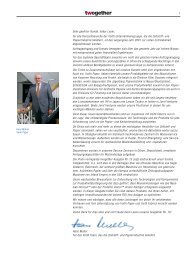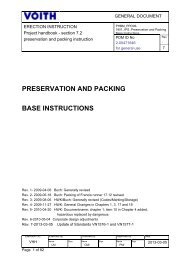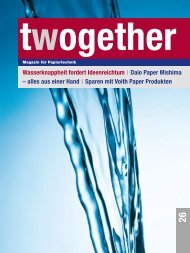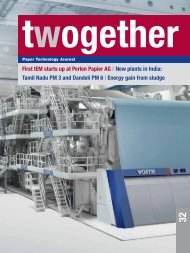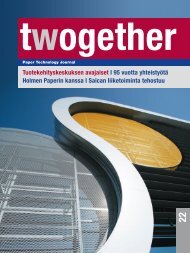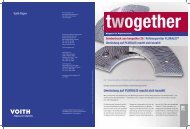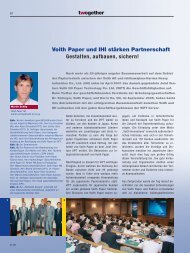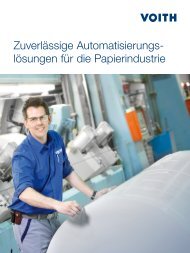Paper Technology Journal 19 - Voith
Paper Technology Journal 19 - Voith
Paper Technology Journal 19 - Voith
Create successful ePaper yourself
Turn your PDF publications into a flip-book with our unique Google optimized e-Paper software.
6<br />
Fig. 4: Reel section with Janus MK 2<br />
and Sirius reel.<br />
Fig. 5: TopDuoRun dryer section.<br />
Fig. 6: The EcoCell primary cells for<br />
post-flotation in DIP 3.<br />
Based on this, the rebuild concept for<br />
them was prepared.<br />
For the capacity increase not only the existing<br />
machines but also all the peripherals<br />
had to be taken into consideration.<br />
This was undertaken within the framework<br />
of the basic and detail engineering,<br />
also carried out by <strong>Voith</strong>.<br />
The major bottlenecks in DIP 1 were<br />
pulping, MC slotted screening and thickening,<br />
in DIP 3 thick stock cleaning,<br />
pre- and post-flotation and likewise thickening.<br />
By re-arranging the process layout and<br />
modifications to existing machines, the<br />
extent of new investment has been<br />
reduced to a minimum. <strong>Voith</strong> supplied a<br />
Fiberizer for DIP 1 to assist pulper discharge<br />
operations as well as a vat thickener<br />
which was installed in parallel with<br />
the existing thickener. The supply for<br />
DIP 3 mainly consisted of an EcoCell<br />
primary flotation stage for post-flotation,<br />
consisting of five cells and the recently<br />
developed EcoGaus foam killer, which<br />
effectively destroys the foam directly in<br />
the foam collecting channel. The existing<br />
flotation cells that became free were split<br />
up and installed in parallel with the<br />
primary cells in the pre-flotation stage as<br />
well as providing a new secondary stage<br />
for post-flotation. This now allows the<br />
mill to operate a separate loop layout.<br />
As part of the expansion of the deinking<br />
plants DIP 1 and DIP 3, <strong>Voith</strong> <strong>Paper</strong><br />
Automation provided the entire control<br />
and instrumentation engineering, including<br />
the logic diagrams. The new components<br />
have been seamlessly integrated<br />
into the existing process control system<br />
and the group controls for new and old<br />
conponents optimally combined. In DIP 1<br />
the old process control system has been<br />
completely exchanged for a new one.<br />
Installation and start-up were also carried<br />
out by <strong>Voith</strong>.<br />
The results are convincing: both the contractually<br />
agreed production increases<br />
and also the promised quality parameters<br />
were reached shortly after start-up of DIP<br />
1 and 3.<br />
Carsten<br />
Wenk<br />
Production<br />
Manager<br />
Stora Enso<br />
Maxau Mill<br />
23<br />
“With a great deal of commitment and<br />
competence on the part of all those<br />
involved, the time pressure was successfully<br />
withstood. Even if the originally<br />
planned deadline for ,<strong>Paper</strong> on<br />
Pope‘ was delayed by three days, the<br />
start-up team brought forward by two<br />
days the goal of producing salable<br />
paper by September 24 at the latest.<br />
From ,Stock on Wire‘ up to the first<br />
salable roll in eleven days – that is top<br />
performance. A good quality approved<br />
by our customers has been uninterruptedly<br />
produced since September 24,<br />
2004.“<br />
By modifying the pulper helix and installing<br />
the additional Fiberizer in DIP 1,<br />
pulping capacity significantly increased<br />
and pulping quality as well as contaminants<br />
discharge were further improved.<br />
Initial stickies tests showed a 50% reduction<br />
of the stickies content in the finished<br />
stock, – a factor mainly attributable<br />
to the modifications in the individual<br />
screening stages.<br />
Although the production of both DIP<br />
plants was significantly increased, brightness<br />
of the finished stock has been maintained<br />
at a high level. In addition, by rearranging<br />
the pre- and post-flotation<br />
stages in DIP 3, bleaching chemicals<br />
have been significantly reduced. Achieving<br />
the required objectives in such a<br />
short time was only possible thanks to a<br />
smooth and close cooperation between<br />
supplier and customer.<br />
<strong>19</strong>/05



